Evaluation of Mechanical and Thermal Properties of Polypropylene-Based Nanocomposites Reinforced with Silica Nanofillers via Melt Processing Followed by Injection Molding
Abstract
:1. Introduction
2. Materials and Methodology
3. Results and Discussion
3.1. Mechanical Properties of the Neat PP and PP-NS Nanocomposites
3.2. Dynamic Mechanical Analysis (DMA) of the Neat PP and PP-NS Nanocomposites
3.3. Thermal Stability of the Neat PP and PP-NS Nanocomposites
3.4. Water Absorption of the Neat PP and PP-NS Nanocomposites
3.5. Differential Scanning Calorimetry (DSC) of the Neat PP and PP-NS Nanocomposites
4. Conclusions
- The ductility (% elongation at break) was significantly improved with the addition of nano-silica, while the tensile strength, modulus, and impact toughness decreased with nano-silica addition as compared to the as-received PP HHR102.
- The storage modulus was optimal when the wt.% of nano-silica was high (3%). The thermal stability was improved at a weight loss of 30%; however, it was unaffected at 50% and 70%, particularly for the PP nanocomposite containing 1 wt.% nano-silica.
- The imbibition was optimal when the nanocomposite weight percentage was lowest. However, a significant increase in water uptake was observed for all samples with imbibition time. It is suggested that the micro-voids generated during ageing provide channels for water absorption, and it progresses with imbibition time.
- The degree of crystallinity of the nanocomposites was slightly decreased as compared to the as-received polypropylene, because the nanoparticles inhibited the regular packing of polymer molecules, thus restricting the movement of PP chains.
Author Contributions
Funding
Data Availability Statement
Conflicts of Interest
References
- Zhang, W.; Xu, J. Advanced Lightweight Materials for Automobiles: A Review. Mater. Des. 2022, 221, 110994. [Google Scholar] [CrossRef]
- Sutar, H.; Mishra, B.; Senapati, P.; Murmu, R.; Sahu, D. Mechanical, Thermal, and Morphological Properties of Graphene Nanoplatelet-Reinforced Polypropylene Nanocomposites: Effects of Nanofiller Thickness. J. Compos. Sci. 2021, 5, 24. [Google Scholar] [CrossRef]
- Ryu, H.-J.; Hang, N.T.; Rejinold, N.S.; Jeong, B.; Choi, G.; Choy, J.-H. Effects of Nanofillers Based on Cetyltrimethylammonium-Modified Clays in a Polypropylene Nanocomposite. Polymers 2022, 14, 4110. [Google Scholar] [CrossRef]
- Joost, W.J. Reducing Vehicle Weight and Improving U.S. Energy Efficiency Using Integrated Computational Materials Engineering. JOM 2012, 64, 1032–1038. [Google Scholar] [CrossRef]
- Mat Rozi, N.; Hamid, H.A.; Hossain, M.S.; Khalil, N.A.; Ahmad Yahaya, A.N.; Syimir Fizal, A.N.; Haris, M.Y.; Ahmad, N.; Zulkifli, M. Enhanced Mechanical and Thermal Properties of Modified Oil Palm Fiber-Reinforced Polypropylene Composite via Multi-Objective Optimization of In Situ Silica Sol-Gel Synthesis. Polymers 2021, 13, 3338. [Google Scholar] [CrossRef] [PubMed]
- Patil, A.; Patel, A.; Purohit, R. An Overview of Polymeric Materials for Automotive Applications. Mater. Today Proc. 2017, 4, 3807–3815. [Google Scholar] [CrossRef]
- Naskar, A.K.; Keum, J.K.; Boeman, R.G. Polymer Matrix Nanocomposites for Automotive Structural Components. Nat. Nanotechnol. 2016, 11, 1026–1030. [Google Scholar] [CrossRef] [PubMed]
- Yuan, W.; Wang, F.; Chen, Z.; Gao, C.; Liu, P.; Ding, Y.; Zhang, S.; Yang, M. Efficient Grafting of Polypropylene onto Silica Nanoparticles and the Properties of PP/PP-g-SiO2 Nanocomposites. Polymer 2018, 151, 242–249. [Google Scholar] [CrossRef]
- Chuang, W.; Geng-sheng, J.; Lei, P.; Bao-lin, Z.; Ke-zhi, L.; Jun-long, W. Influences of Surface Modification of Nano-Silica by Silane Coupling Agents on the Thermal and Frictional Properties of Cyanate Ester Resin. Results Phys. 2018, 9, 886–896. [Google Scholar] [CrossRef]
- Omar, M.F.; Akil, H.M.; Ahmad, Z.A. Particle Size—Dependent on the Static and Dynamic Compression Properties of Polypropylene/Silica Composites. Mater. Des. 2013, 45, 539–547. [Google Scholar] [CrossRef]
- Mirjalili, F. Crystallization Behavior and Tensile Performance of Nanoparticle-Filled Polypropylene Composites. J. Compos. Mater. 2013, 48, 2915–2924. [Google Scholar] [CrossRef]
- Kościuszko, A.; Czyżewski, P.; Rojewski, M. Modification of Laser Marking Ability and Properties of Polypropylene Using Silica Waste as a Filler. Materials 2021, 14, 6961. [Google Scholar] [CrossRef] [PubMed]
- Sathees Kumar, S.; Muthalagu, R.; Nithin Chakravarthy, C.H. Effects of Fiber Loading on Mechanical Characterization of Pineapple Leaf and Sisal Fibers Reinforced Polyester Composites for Various Applications. Mater. Today Proc. 2021, 44, 546–553. [Google Scholar] [CrossRef]
- Bala, N.; Napiah, M.; Kamaruddin, I. Effect of Nanosilica Particles on Polypropylene Polymer Modified Asphalt Mixture Performance. Case Stud. Constr. Mater. 2018, 8, 447–454. [Google Scholar] [CrossRef]
- Jang, H.; Hong, T.; Yoo, J.; Lee, S.; Pyo, J.; Sutradhar, S.C.; Ju, H.; Kim, W. Preparation and Characterization of Sulfonated Poly(Phenylene)s Membranes Containing Conjugated Moiety via Nickel Catalyzed Carbon–Carbon Coupling Polymerization. Int. J. Hydrogen Energy 2015, 40, 14364–14370. [Google Scholar] [CrossRef]
- Ponnusamy, M.; Natrayan, L.; Kaliappan, S.; Velmurugan, G.; Thanappan, S. Effectiveness of Nanosilica on Enhancing the Mechanical and Microstructure Properties of Kenaf/Carbon Fiber-Reinforced Epoxy-Based Nanocomposites. Adsorpt. Sci. Technol. 2022, 2022, 4268314. [Google Scholar] [CrossRef]
- Yeasmin, F.; Mallik, A.K.; Chisty, A.H.; Robel, F.N.; Shahruzzaman, M.; Haque, P.; Rahman, M.M.; Hano, N.; Takafuji, M.; Ihara, H. Remarkable Enhancement of Thermal Stability of Epoxy Resin through the Incorporation of Mesoporous Silica Micro-Filler. Heliyon 2021, 7, e05959. [Google Scholar] [CrossRef]
- Ahmad, F.N.; Jaafar, M.; Palaniandy, S.; Azizli, K.A.M. Effect of Particle Shape of Silica Mineral on the Properties of Epoxy Composites. Compos. Sci. Technol. 2008, 68, 346–353. [Google Scholar] [CrossRef]
- Sun, J.; Chang, X.; Zhang, F.; Bai, Y.; Lv, K.; Wang, J.; Zhou, X.; Wang, B. Salt-Responsive Zwitterionic Polymer Brush Based on Modified Silica Nanoparticles as a Fluid-Loss Additive in Water-Based Drilling Fluids. Energy Fuels 2020, 34, 1669–1679. [Google Scholar] [CrossRef]
- Wu, C.; Gao, Y.; Liang, X.; Gubanski, S.M.; Wang, Q.; Bao, W.; Li, S. Manifestation of Interactions of Nano-Silica in Silicone Rubber Investigated by Low-Frequency Dielectric Spectroscopy and Mechanical Tests. Polymers 2019, 11, 717. [Google Scholar] [CrossRef]
- Chammingkwan, P.; Takeuchi, K.; Wada, T.; Terano, M.; Taniike, T. Template-Based Orientation Control of Nanoparticles toward Mechanically Reinforced Polypropylene/Silica Nanocomposites. Compos. Sci. Technol. 2023, 231, 109804. [Google Scholar] [CrossRef]
- Liu, F.; Yao, H.; Liu, Q.; Wang, X.; Dai, X.; Zhou, M.; Wang, Y.; Zhang, C.; Wang, D.; Deng, Y. Nano-Silica/Polymer Composite as Filtrate Reducer in Water-Based Drilling Fluids. Colloids Surf. A Physicochem. Eng. Asp. 2021, 627, 127168. [Google Scholar] [CrossRef]
- Awad, S.A.; Khalaf, E.M. Investigation of Improvement of Properties of Polypropylene Modified by Nano Silica Composites. Compos. Commun. 2019, 12, 59–63. [Google Scholar] [CrossRef]
- Naseem, S.; Wießner, S.; Kühnert, I.; Leuteritz, A. Layered Double Hydroxide (MgFeAl-LDH)-Based Polypropylene (PP) Nanocomposite: Mechanical Properties and Thermal Degradation. Polymers 2021, 13, 3452. [Google Scholar] [CrossRef] [PubMed]
- ASTM Standard D638-14; Standard Test Method for Tensile Properties of Plastics. ASTM International: West Conshohocken, PA, USA, 2014. [CrossRef]
- Hariprasad, K.; Ravichandran, K.; Jayaseelan, V.; Muthuramalingam, T. Acoustic and Mechanical Characterisation of Polypropylene Composites Reinforced by Natural Fibres for Automotive Applications. J. Mater. Res. Technol. 2020, 9, 14029–14035. [Google Scholar] [CrossRef]
- Huang, L.; Zhan, R.; Lu, Y. Mechanical Properties and Crystallization Behavior of Polypropylene/Nano-SiO2 Composites. J. Reinf. Plast. Compos. 2006, 25, 1001–1012. [Google Scholar] [CrossRef]
- Adediran, A.A.; Akinwande, A.A.; Balogun, O.A.; Bello, O.S.; Akinbowale, M.K.; Adesina, O.S.; Ojo, A.A. Mechanical and Optimization Studies of Polypropylene Hybrid Biocomposites. Sci. Rep. 2022, 12, 2468. [Google Scholar] [CrossRef]
- Jyoti, J.; Singh, B.P.; Arya, A.K.; Dhakate, S.R. Dynamic Mechanical Properties of Multiwall Carbon Nanotube Reinforced ABS Composites and Their Correlation with Entanglement Density, Adhesion, Reinforcement and C Factor. RSC Adv. 2016, 6, 3997–4006. [Google Scholar] [CrossRef]
- AL-Oqla, F.M.; Hayajneh, M.T.; Al-Shrida, M.M. Mechanical Performance, Thermal Stability and Morphological Analysis of Date Palm Fiber Reinforced Polypropylene Composites toward Functional Bio-Products. Cellulose 2022, 29, 3293–3309. [Google Scholar] [CrossRef]
- Nourbakhsh, A.; Baghlani, F.F.; Ashori, A. Nano-SiO2 Filled Rice Husk/Polypropylene Composites: Physico-Mechanical Properties. Ind. Crops Prod. 2011, 33, 183–187. [Google Scholar] [CrossRef]
- Li, H.; Cheng, B.; Gao, W.; Feng, C.; Huang, C.; Liu, Y.; Lu, P.; Zhao, H. Recent Research Progress and Advanced Applications of Silica/Polymer Nanocomposites. Nanotechnol. Rev. 2022, 11, 2928–2964. [Google Scholar] [CrossRef]

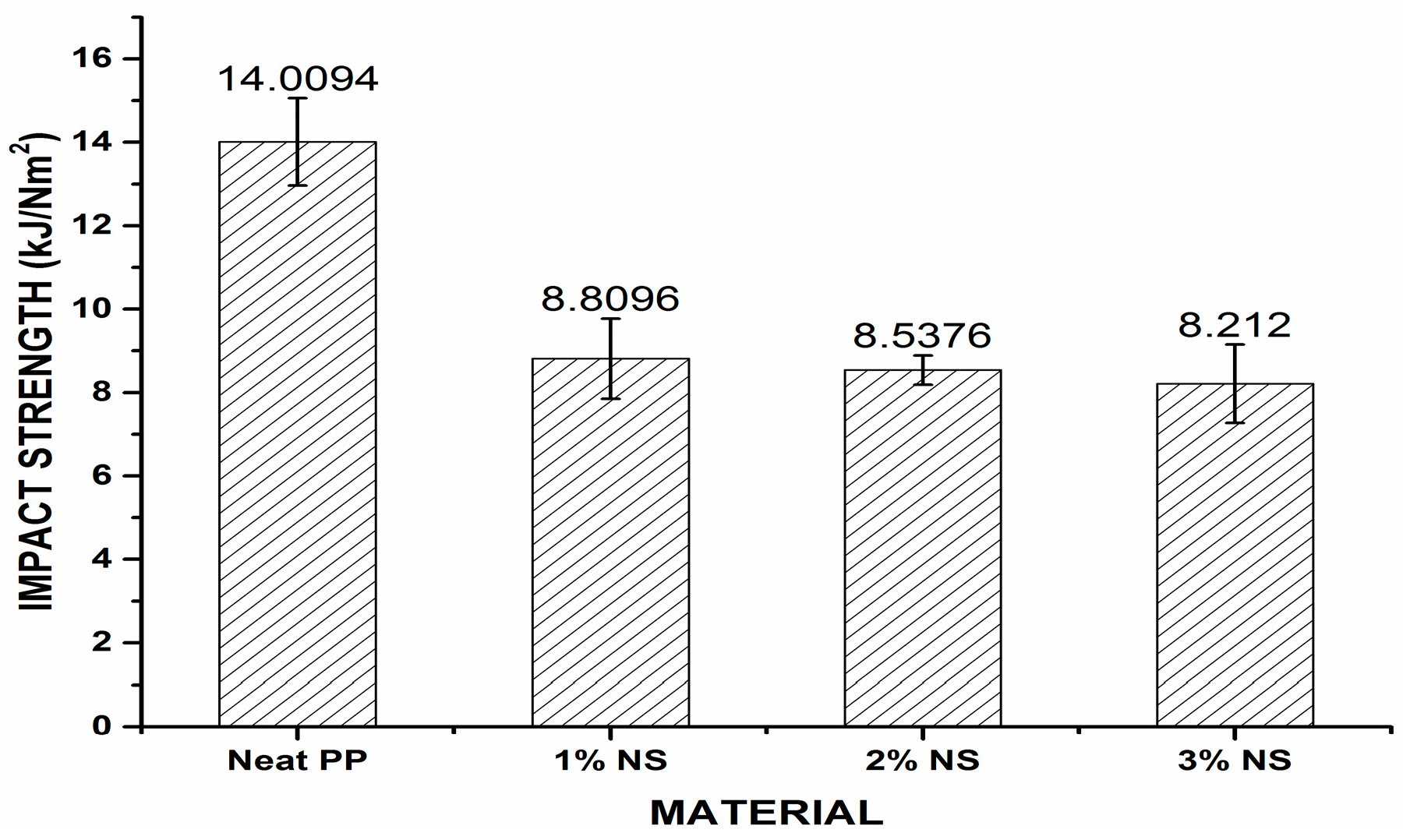
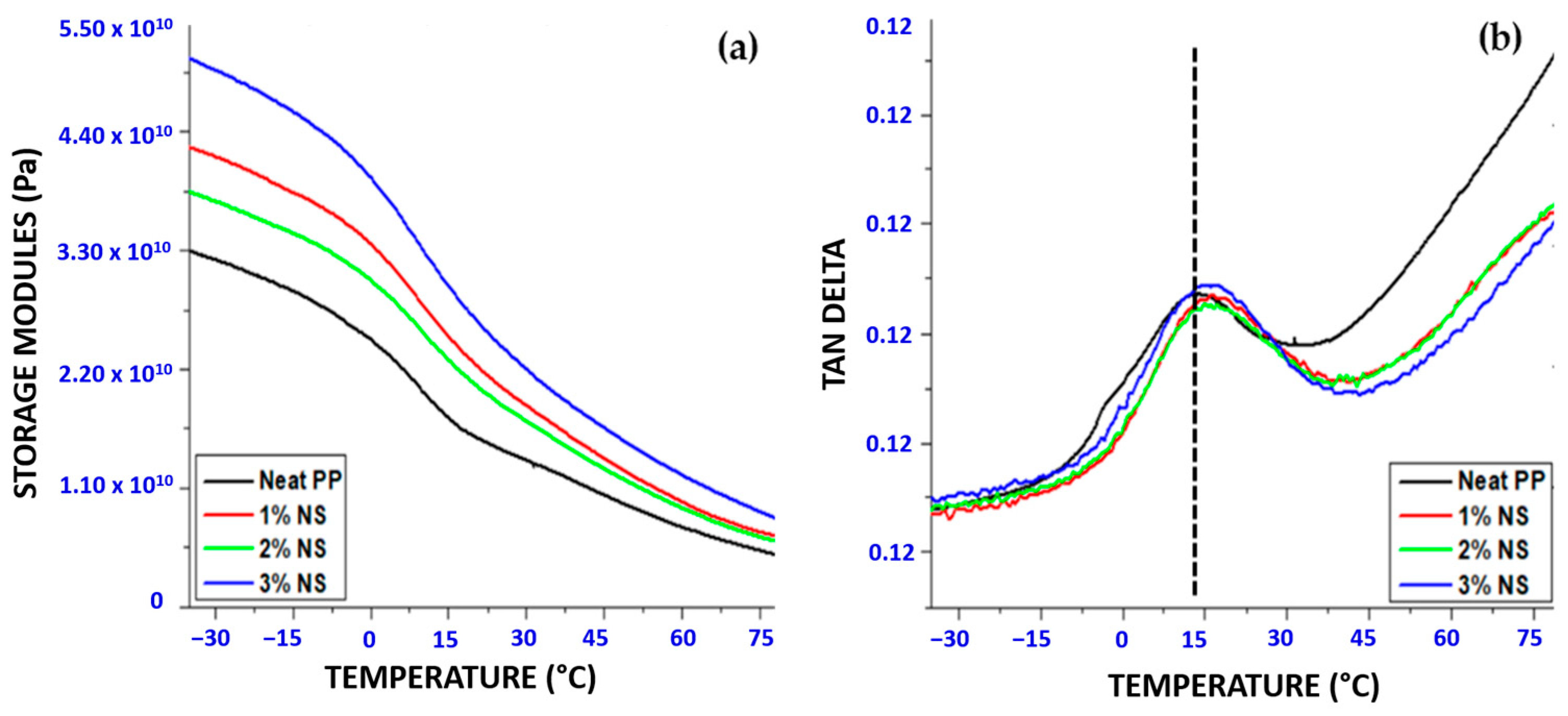
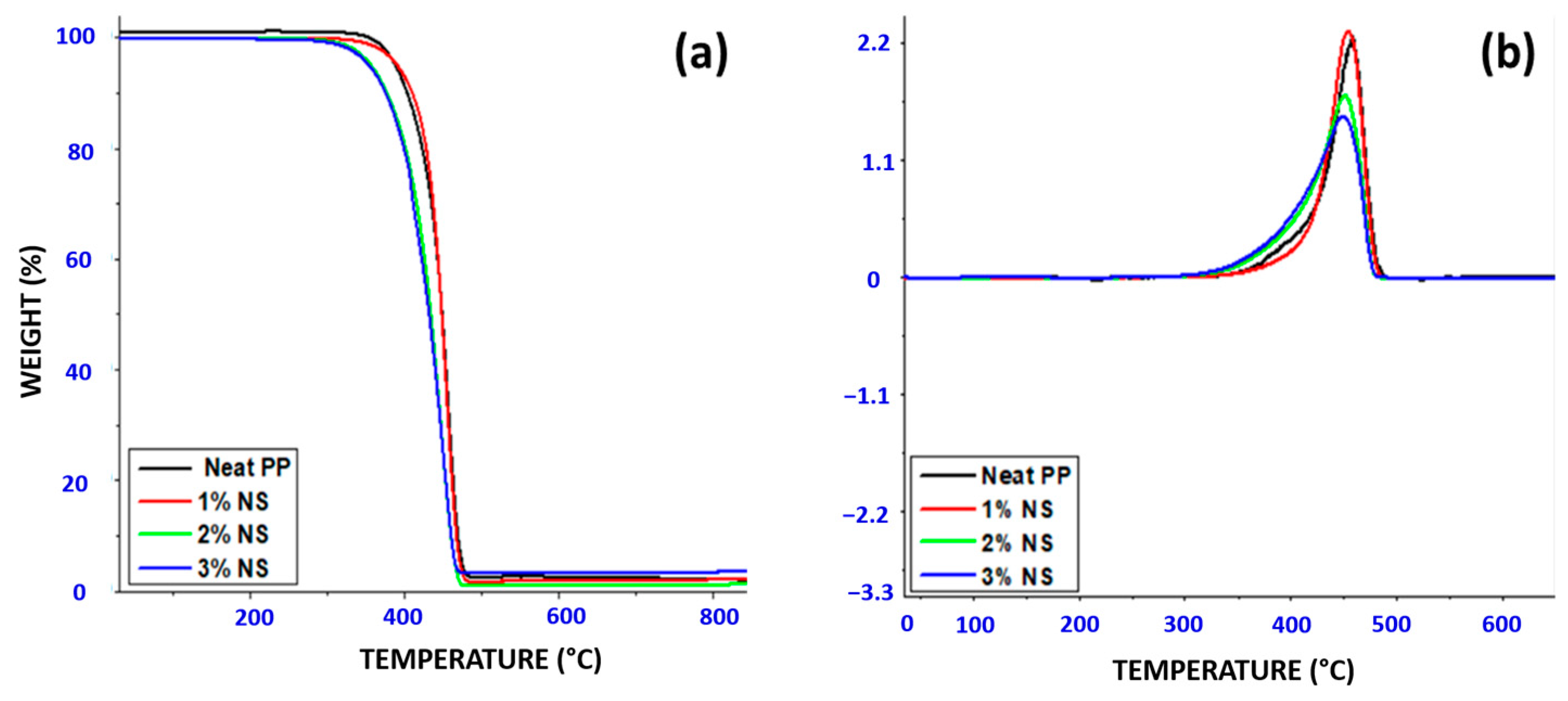
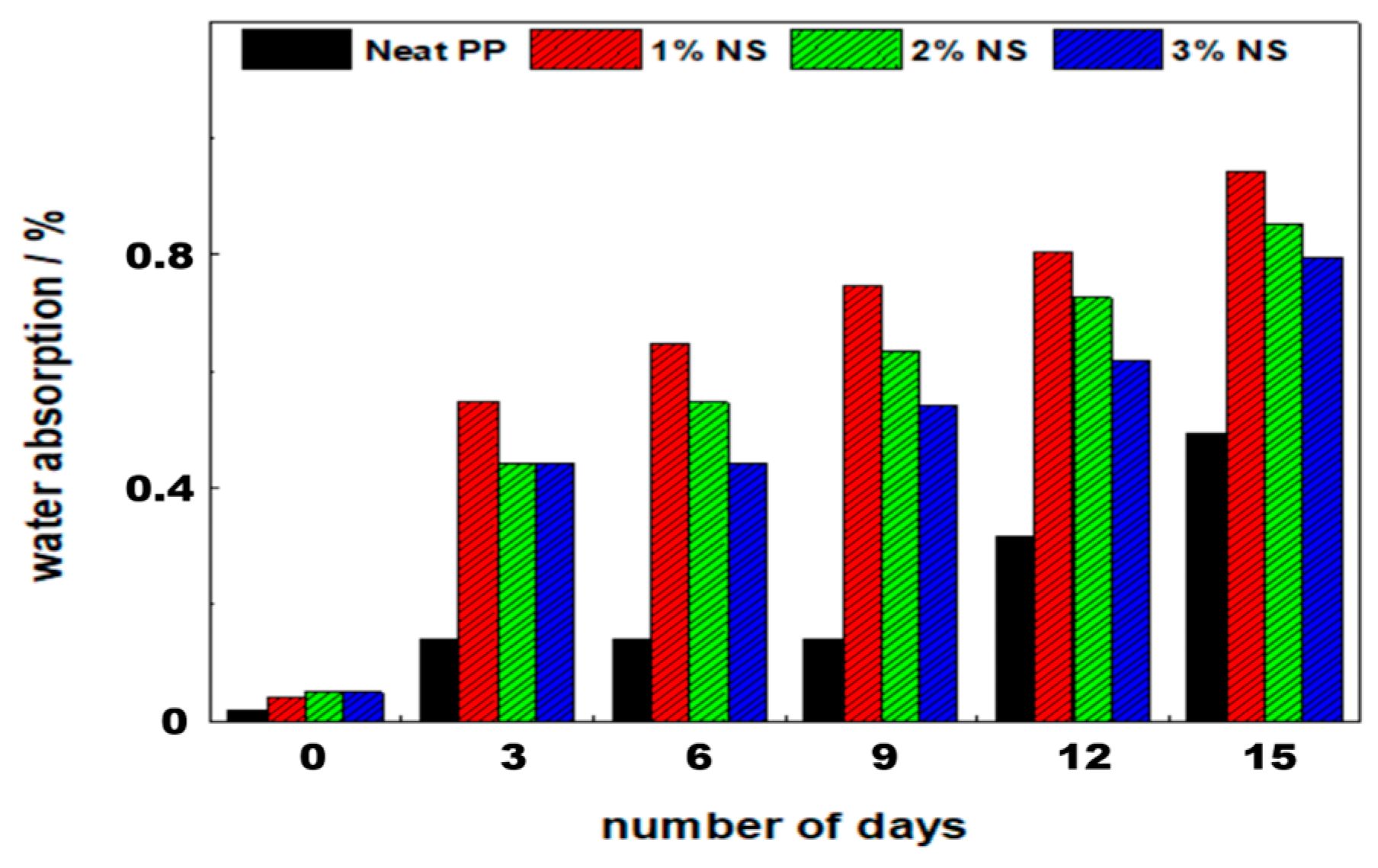
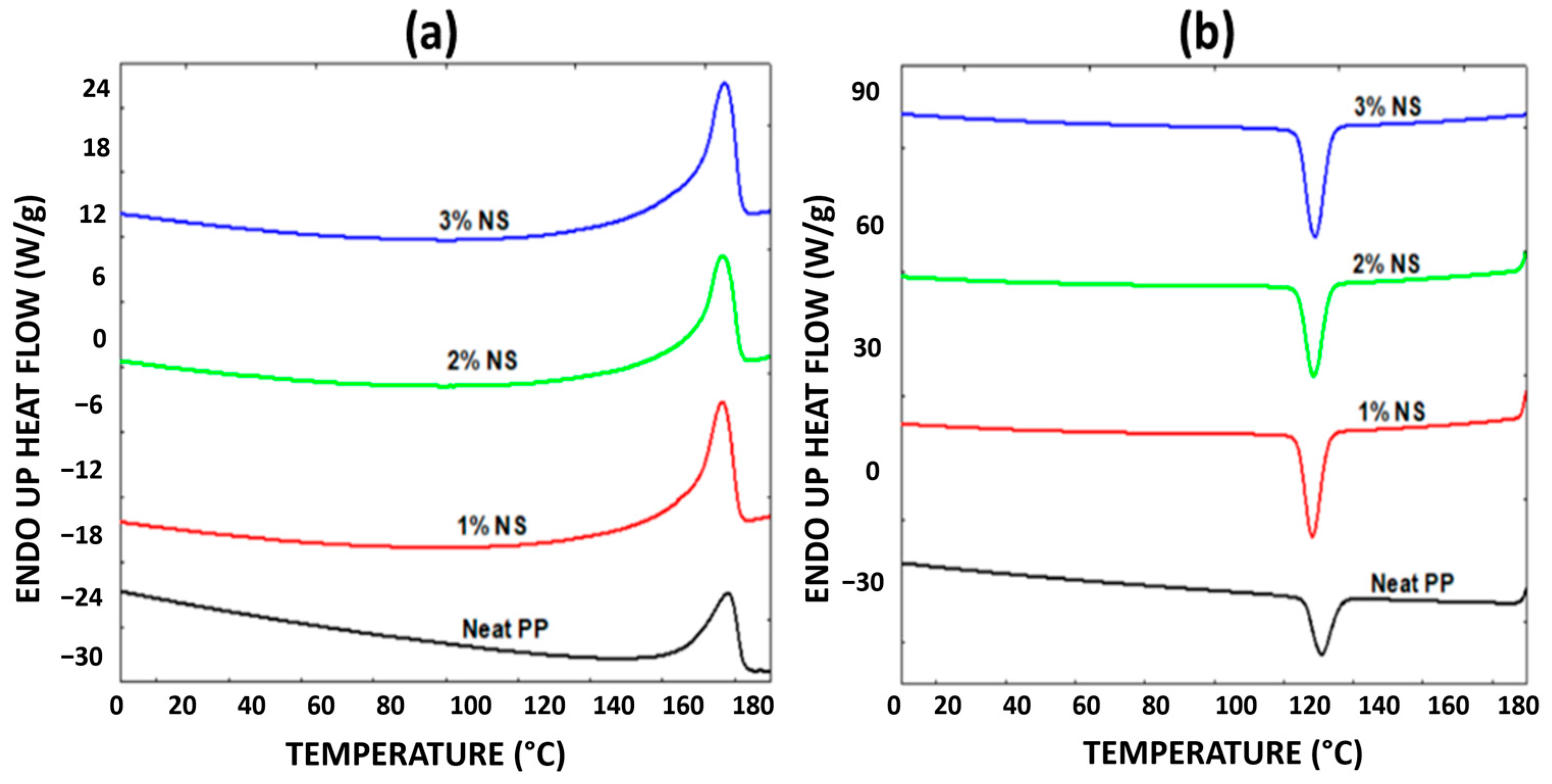
| Neat PP (wt.%) | NS (wt.%) Batch 1 |
|---|---|
| 100 | 0 |
| 99 | 1 |
| 98 | 2 |
| 97 | 3 |
| Material | Tensile Modulus (MPa) | Tensile Strength (MPa) | Elongation at Break (%) | |||
|---|---|---|---|---|---|---|
| Mean | Std. Dev. | Mean | Std. Dev. | Mean | Std. Dev. | |
| Neat PP | 1351.0 ± 115.5 | 45.5 ± 0.6 | 28.5 ± 6.8 | |||
| 1% NS | 1248.5 ± 110.2 | 41.8 ± 1.5 | 641.0 ± 0.2 | |||
| 2% NS | 1236.6 ± 43.8 | 41.4 ± 0.8 | 641.1 ± 0.1 | |||
| 3% NS | 1356.0 ± 89.9 | 42.6 ± 1.1 | 641.1 ± 0.3 | |||
| Material | T30 wt.% (°C) | T50 wt.% (°C) | T70 wt.% (°C) | TMax (°C) |
|---|---|---|---|---|
| Neat PP | 435 | 449 | 458 | 458 |
| 1% NS | 437 | 448 | 457 | 453 |
| 2% NS | 416 | 434 | 447 | 450 |
| 3% NS | 411 | 432 | 447 | 449 |
| Material | Mean Tc (°C) | Mean Tm (°C) | Average ΔHm (J·g−1) | χc (%) |
|---|---|---|---|---|
| Neat PP | 119.78 | 166.98 | 90.31 | 45.61 |
| 1% NS | 118.01 | 166.27 | 87.99 | 44.44 |
| 2% NS | 118.56 | 166.36 | 87.75 | 44.32 |
| 3% NS | 119.33 | 166.58 | 100.80 | 50.91 |
Disclaimer/Publisher’s Note: The statements, opinions and data contained in all publications are solely those of the individual author(s) and contributor(s) and not of MDPI and/or the editor(s). MDPI and/or the editor(s) disclaim responsibility for any injury to people or property resulting from any ideas, methods, instructions or products referred to in the content. |
© 2023 by the authors. Licensee MDPI, Basel, Switzerland. This article is an open access article distributed under the terms and conditions of the Creative Commons Attribution (CC BY) license (https://creativecommons.org/licenses/by/4.0/).
Share and Cite
Seshweni, M.H.E.; Makhatha, M.E.; Botlhoko, O.J.; Obadele, B.A.; Vijayan, V.; Chiniwar, D.S.; Kumar, P.; H. M., V. Evaluation of Mechanical and Thermal Properties of Polypropylene-Based Nanocomposites Reinforced with Silica Nanofillers via Melt Processing Followed by Injection Molding. J. Compos. Sci. 2023, 7, 520. https://doi.org/10.3390/jcs7120520
Seshweni MHE, Makhatha ME, Botlhoko OJ, Obadele BA, Vijayan V, Chiniwar DS, Kumar P, H. M. V. Evaluation of Mechanical and Thermal Properties of Polypropylene-Based Nanocomposites Reinforced with Silica Nanofillers via Melt Processing Followed by Injection Molding. Journal of Composites Science. 2023; 7(12):520. https://doi.org/10.3390/jcs7120520
Chicago/Turabian StyleSeshweni, Mantsha Hennie Erna, Mamookho Elizabeth Makhatha, Orebotse Joseph Botlhoko, Babatunde Abiodun Obadele, Vijeesh Vijayan, Dundesh S. Chiniwar, Pawan Kumar, and Vishwanatha H. M. 2023. "Evaluation of Mechanical and Thermal Properties of Polypropylene-Based Nanocomposites Reinforced with Silica Nanofillers via Melt Processing Followed by Injection Molding" Journal of Composites Science 7, no. 12: 520. https://doi.org/10.3390/jcs7120520






